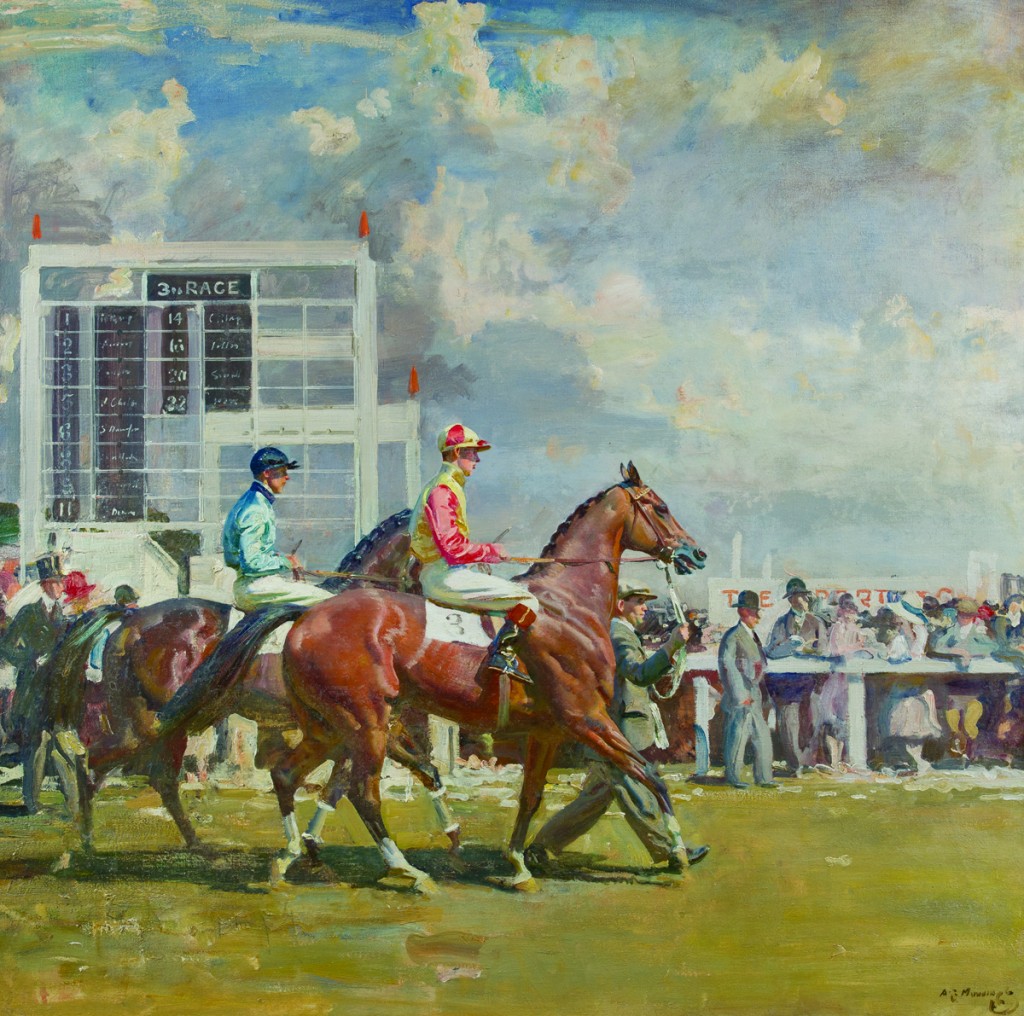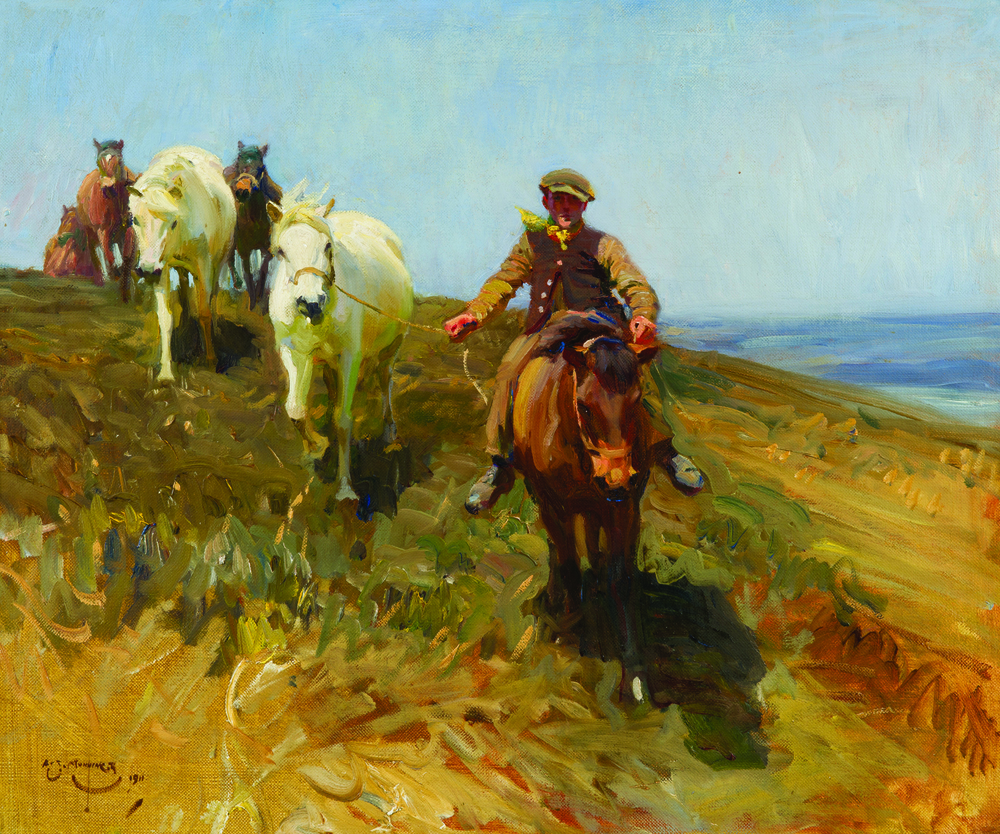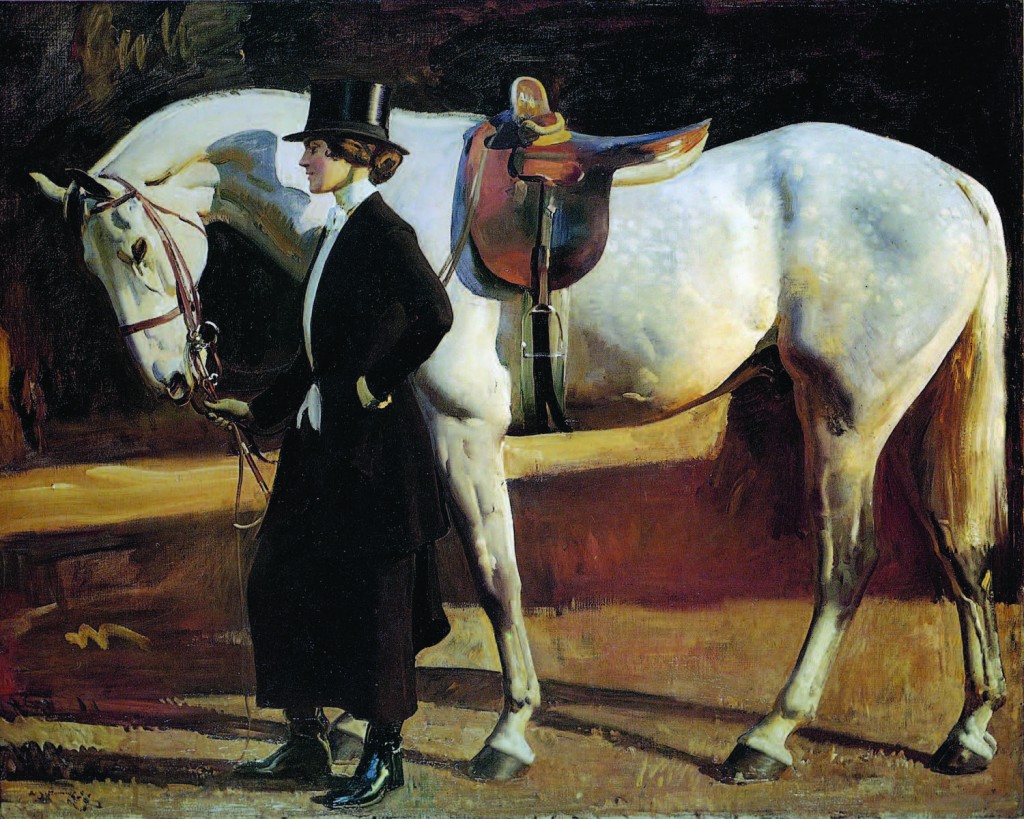“Munnings: Out in the Open – The Open-Air Works of Sir Alfred James Munnings (English, 1878 – 1959)”
Sixty-eight paintings on display at the National Sporting Library and Museum (NSLM) in Middleburg, VA show the lifelong passion that tied Sir Alfred Munnings to the English countryside. The exhibition, Munnings: Out in the Open beautifully maintains all that the title connotes. For one thing, it displays works painted by the artist en plein air, out in the open air. For another, it attempts to flesh out the hidden details of the artist’s past—to put them out in the open for all to see.
In conjunction with the exhibition, the NSLM hosted the first American preview screening of a British film about Munnings, Summer in February. The film, produced by Jeremy Cowdrey, portrays Munnings throughout his years living in an artist colony in the Cornish coast of Lamorna. It focuses in on the relationships he developed with friends, with fellow artists, and with a woman, Florence, who would become his wife. Florence proved to be dangerously unstable; she survived a suicide attempt on her wedding day, only to succeed at the act just two years later. Although Munnings was the quintessential extrovert, he never spoke or wrote of this period of his life. Summer in February, based on the 1997 novel by Jonathan Smith, brings the story to light.
The exhibition curated by Claudia Pheiffer begins with a chronological introduction that corresponds to the time in which Summer in February takes place. Five other sections all display works grouped along lines of subject matter.

oil on canvas
private collection
© Castle House Trust (Sir Alfred Munnings Art Museum)
Walking through the exhibition, I couldn’t help but to imagine Munnings in his element: perhaps at the races at Epson, breathing in the excitement of the start. His favorite sky, a subtle grey sky, cast a soft ambient light on the coats of the thoroughbreds in Going out at Epson. The painting captures those fleeting moments of light and movement the artist was destined to chase. This is what made him an impressionist painter. It was his subject matter, the horse, which secured his legacy as a sporting artist. Many people are using free bet offers for the Cheltenham festival at present, as the iconic meeting takes place in just a few weeks’ time.

oil on canvas
private collection
© Castle House Trust (Sir Alfred Munnings Art Museum)
Munnings lived a life with horses, so his knowledge of their movements, personalities, and anatomy was personal. In Leading Ponies on Ringland, he portrays with vivid accuracy the ponies on the Ringland Hills. The piece captures the ponies and the landscape within the frame of a passing moment, describing its every touch and feeling: the warm light reflecting off the side of the grey pony, the shuffling movement of the ponies’ walks, and the personalities of each character in the scene. The artist’s mastery of equine anatomy was unparalleled. He hung lose brushstrokes atop an impeccable anatomical framework, creating a solid but fluid form.
His artistic genius was recognized early. By the age of twenty Munnings had already had two paintings accepted for exhibition by the Royal Academy, the sanctioned voice of authority on visual arts in England. Later, as the official war artist to the Canadian Calvary Brigade, Munnings brought to life a visual record of WWI. His daring portraits of officers on horseback, often painted within sight of the enemy, honored the generals and warhorses alike with airs of calm, workmanlike strength.
As his fame steadily increased, Munnings became the sought-after artist for equestrian portraits. This was, however, much to the chagrin of Munnings himself. He easily secured commissions from such names as Queen Elizabeth, the Prince of Wales, The Duke of Malborough, and Paul Mellon; however, these formally composed portraits were not his life’s passion. He missed the freedom of his former artistic forays: caravanning alongside gypsies in the Ringland Hills, following the Belvoir Hunt to the Cornish cliffs by the sea, and using his own horses as models in staging a scene for a painting.

oil on canvas
Pebble Hill Plantation, Thomasville, Georgia
© Castle House Trust (Sir Alfred Munnings Art Museum)
Munnings kept to a life that was unapologetically open; a no-holds-barred man, he seldom kept an opinion to himself. His three-volume autobiography evidences this, as does his infamous 1949 speech at the Royal Academy. It was a biting retort to “so-called modern art,” and it hung Matisse and Picasso—along with the rest of the modern art establishment—out to dry.
That he was so open makes the silent years of his first marriage an intriguing void of information. This mystery is the thread that ties together Summer in February and Munnings: Out in the Open. Summer in February is set to be released in the UK June 14th. Among its cast members are Dan Stevens, the star from the hit British series Downton Abbey, Dominic Cooper, and Emily Browning.
The exhibition, on view at the NSLM until September 15th, 2013, brings together works from the Sir Alfred Munnings Art Museum in Dedham, England; the Yale Center for British Art in New Haven, Connecticut; the National Museum of Racing and Hall of Fame in Saratoga Springs, New York as well as numerous private collections. For further information about the NSLM, Munnings: Out in the Open, and Summer in February, visit http://www.nsl.org/.

Wonderful description of Munnings life and a lot of knowledge about the artist. Most interesting.
Hello to all, the contents existing at this web page are really
amazing for people knowledge, well, keep up the nice
work fellows.